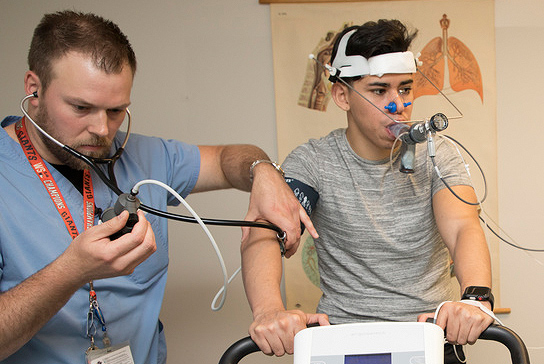Heart Rate
What is heart rate?
The cardiovascular system circulates blood throughout the body in order to supply oxygen and other nutrients and to remove waste products. Each time the heart beats; blood is pumped out of the heart and into the body to supply oxygen to working muscles or to the lungs for re-oxygenation. Heart rate refers to the number of times the heart beats per minute, and is directly related to the workload being placed on the heart. When the body is in a resting state (i.e. lying down in a quiet area for at least five minutes), resting heart rate is measured. A normal resting heart rate ranges from 60-100 beats per minute (bpm). Resting rates higher than 100 bpm suggest that the heart is working too hard to circulate blood, and thus may indicate a serious problem that should be monitored by a physician. Resting rates lower than 60 bpm occur more often with endurance-trained athletes whose bodies are more efficient at utilizing oxygen from the blood.


Heart rate is controlled by the two branches of the autonomic (involuntary) nervous system. The sympathetic nervous system (SNS) and the parasympathetic nervous system (PNS). The sympathetic nervous system (SNS) releases the hormones (catecholamines - epinephrine and norepinephrine) to accelerate the heart rate. The parasympathetic nervous system (PNS) releases the hormone acetylcholine to slow the heart rate. Such factors as stress, caffeine, and excitement may temporarily accelerate your heart rate, while meditating or taking slow, deep breaths may help to slow your heart rate. Exercising for any duration will increase your heart rate and will remain elevated for as long as the exercise is continued. At the beginning of exercise, your body removes the parasympathetic stimulation, which enables the heart rate to gradually increase. As you exercise more strenuously, the sympathetic system “kicks in” to accelerate your heart rate even more. Regular participation in cardiovascular exercise over an extended period of time can decrease your resting heart rate by increasing the hearts size, the contractile strength and the length of time the heart fills with blood. The reduced heart rate results from an increase in activity of the parasympathetic nervous system, and perhaps from a decrease in activity of the sympathetic nervous system.
Higher heart rates may be an indication of poor heart function and higher than usual stress being placed on the hearts ability to circulate blood. This may further indicate heart disease conditions.
From a performance stand point knowing specific heart rate training zones can optimize our body’s ability to adapt to performance requirements. Determining these zones can be done through many different methods, including VO2 or lactate testing, formulas and general training regimens. It then becomes necessary to monitor intensity in order to optimize your chances for success. To monitor your intensity there are several methods available to you. First is the perceived exertion method in which you rate your perception of how hard you are exerting yourself during a workout. The acronym for this is RPE (Rating of Perceived Exertion). The scale on which to base your perceptions range from 1 - 10. See below.
The scale can be broken down as follows:
0: Nothing at all
0.5: Very, very easy
1: Very easy
2: Easy
3: Moderate
4: Somewhat strong
5: Strong
6:
7: Very strong
8:
9: Very, very strong
10: Maximal
As you have noticed, the scale increases non-linearly. Most of your training should be at a rate of perceived exertion of 3. Training sessions designed to increase stamina will have a rating of 4, training sessions designed to increase economy will have a rating of 5-6 and training sessions designed to increase speed will have a rating of 7-9. As everyone knows the harder you work the higher your heart rate gets. Thus, if you have the means of checking your heart rate you can gauge how hard you are working and not have to rely on perception alone. Heart rate monitors are designed to gauge the effort.
Once you have a heart rate monitor it will be necessary to determine your training heart rate zones with VO2 or lactate testing. Using a formula is easy and simple but it can provide incorrect values that can be as much as 15 beats to high or to low. We do not recommend this method be utilized. The training heart rate zone becomes critical when you are trying to monitor your recovery and increase your economy.
